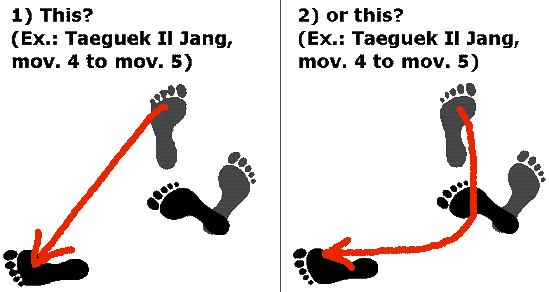Hi everyone!
I love the discussion brought up about the "whys" for perfoming the "crescent step" (this can still be further discussed, I believe), and also about the various ways of front stance as well, but maybe my
second question (made later) has passed unseen in the thread. I don't wanna stop the discussion about the reasons on the different options for stances and stepping ways in each style, but what about this other question of mine (quoted above), regarding Kukkiwon standards when performing turns?
I'll reformulate it to make myself clearer:
According to Kukkiwon, when performing a turn (example: taegeuk il jang from movement 4 to 5 (left ap seogi/mid level punch turning 90º left to left apkubi/arae makki (down block) followed by reverse punch), should we:
1) bring the advancing foot in a straight diagonal line or;
2) first bring the advancing foot closer to the pivot foot and only then advance the foot to its regular place of the finishing stance?
To make it even clearer, I'll draw! (Don't know how I hadn't thought of it previously! Would've helped to describe the "crescent step" pattern as well! Ok, today I have more time than usual.

)
According to Kukkiwon, should we turn like:
I hope this doesn't sound like I'm not interested in reasons why we should perform one way or another -- I'd love to know the reasons for us to do it either way and everyone should feel free to discuss it --, but I've been also curious about KKW standards recently, and I'd like to know whether my school teaches the KKW standard or not (they teach us to do it the #2 way). It would also be great to know if there are different ways to make that turn in different styles (KKW, ITF, shotokan, wado ryu, etc.).
Thanks in advance!


